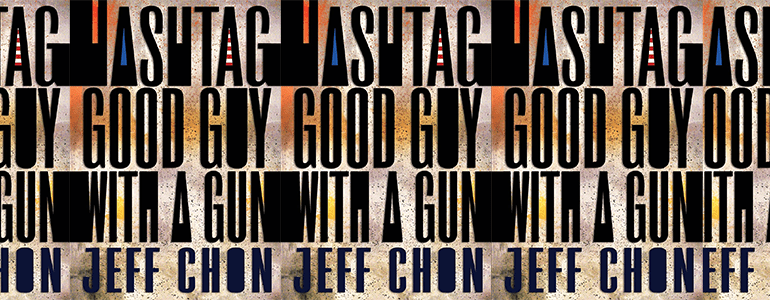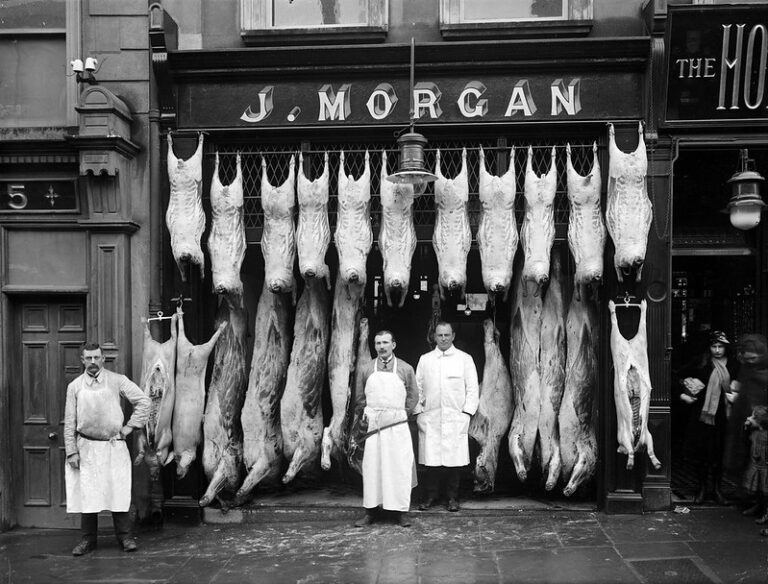Hashtag Good Guy With a Gun’s Unsettling Portrayal of the Dark Cells of the Internet

Jeff Chon’s 2021 novel Hashtag Good Guy with a Gun opens with a scene of chaos. An armed man, David Brightman, walks into a Chuck E. Cheese-like restaurant called Pizza Galley in the middle of the day with the intent of killing his wife, who works at the restaurant, and her lover, the restaurant’s assistant manager. Before he can commit that horrific act, though, he is killed by another armed man, a former high-school English teacher named Scott Bonneville. An employee at the restaurant goes into labor. There’s a birth, a death, and a man’s life changed in the span of the first four pages.
In short time, through omniscient narration, we learn that Scott’s reason for entering the restaurant with a weapon was motivated by delusion—a belief in a wild conspiracy, stoked by rumors circulating on the dark corners of the web, that the restaurant had been the front for an organization involved in heinous acts of child sexual abuse. The choice of a children’s pizza arcade purposefully recalls the “Pizzagate” events of 2016, in which a gunman fired shots inside Washington, D.C., pizza restaurant Comet Ping Pong—more of an adult-oriented establishment than what is depicted in Chon’s book—after being led to believe rumors, which circulated on 4chan, Reddit, and other sites, that the restaurant was secretly hosting a child sex trafficking ring sponsored by the Democratic Party.
Scott’s conspiracy-fueled motives aren’t brought to the public fore. Instead, almost instantly, he is elevated as a folk hero among gun-rights advocates who share his story on social media. “And that was how Scott became #goodguywithagun, a hashtag used by people who pushed horrible, stupid ideas.”
Hashtag Good Guy doesn’t shy away from its obvious real-world parallels—the shooting takes place three days before Donald Trump’s election in 2016, though neither Trump nor Hillary Clinton are mentioned by name (the real-life incident at Comet Ping Pong had taken place on December 4 of that year). And while most of the book’s events use third-person narration, Chon takes the unusual step of switching to the first-person plural in the early paragraphs that establish this backdrop (“On November 8, 2016, the America we’d fooled into existence vanished right before our eyes. No one thought he stood a chance”), which has the strange effect of breaking the narrative plane and thrusting the reader into the universe of this very fictional story. Who is this we that we are suddenly a part of?
This is one element of the strange, enrapturing effect of Chon’s storytelling. This is not a story that we can safely watch from afar, a story with a clear beginning and end. Hashtag Good Guy with a Gun is a book about young, lonely men turned into dark, angry souls by the rot of the internet, the same internet that we use to work, read news, and shop every day. And Chon’s manner of writing about such men is not intended to turn them into captured, detached objects that the reader can observe from safe distance; instead, he molds the story using the very codes and currencies that manufacture that rot, rendering its toxic environment inescapable. They live among us, and we among them.
Scott, a Korean American man, grew up as the son of a Christian cult leader based in Hawaii, “going door to door in an attempt to recruit new converts, being forced to memorize the Bible from Genesis 1:1 to Mark 3:35…watching church members converse (yes, converse) in tongues.” While there, he endured sexual abuse at the hands of one of his father’s henchmen. He found comfort in, among other things, urban legends (“It’s true, he’d once told them. Burger King uses wallaby meat in their Whoppers”) and Superman comics, which he would interpret with the same fanaticism with which he was trained to read the Bible. This backstory is revealed gradually in sessions with a counselor.
As a counterpoint of sorts to Scott, there is Blake Mesman, his former student, whose mother Scott dated before he got fired. Blake is branded a loser in the eyes of everyone who knows him; even Chon’s narration taunts the kid, making us complicit in the meanness of society, calling him “spiritually dull with none of the psychological complexities and intellectual curiosity needed to truly go anywhere … Children like Blake Mesman existed so other children could feel better about themselves.” Scott tries to connect with Blake over their shared love of J. D. Salinger’s The Catcher in the Rye (1951), a book that has been implicated in many a real-world conspiracy; Chon takes us through an entertaining decoding of the references found in Salinger’s novel, tying them to names real and fictional (“Holden even says that Jane Gallagher, the object of his affection, dated a guy named Al Pike, which also happens to be the name of one of the most famous Freemasons in American [history]”), and Scott’s obsessiveness with reading between the lines rubs off on Blake, along with the feeling that the world isn’t telling him the truth. When Scott begins dating Blake’s mother, Blake becomes agitated and resentful, acting out in ways that lead to his expulsion from school.
At his new school, Blake falls under the influence of the Company of Men, a group that adheres to traditional notions of masculinity, antipathy towards women, and violence in the name of maintaining what they believe to be the proper social order. He is educated in the ways of workout routines to improve his looks and of measuring himself according to un-nuanced notions of strength and weakness: “A man needs structure, because without structure, there was nothing to rebel against. And when a man can’t rebel, he becomes complacent, weak. How could he break down walls if none were provided for him?” Scott watches as Blake falls down the same kind of rabbit holes that led him to believe his delusions about Pizza Galley. At the same time, Blake begins to hone his resentment toward Scott, now celebrated as a media hero, and that progression ultimately forms the plot of the book.
The internet allows any unhappy person to seek out their own false reality, one in which things make sense only to them. But one effect of the internet creating so many monsters is that it has made the very idea of becoming a monster less interesting—if anything, it has become exhaustingly banal. The unhappiness of so many people is twisted to be presented as someone else’s fault. Fiction typically keeps the reader engaged by allowing its protagonists small victories along the way, navigating a landscape where not everything is viewed as a force unfairly working against them. But Hashtag Good Guy with a Gun has no real protagonist in the traditional sense—the men at the center of the book do not seek happiness, but need to be saved from themselves.
Chon borrows much of online culture’s currency to make genuine his portrayal of this common experience. He infuses his narrative with devices and references that presume a reader’s literacy with the tropes of the internet: “we’d fail to see we were all like Charles Foster Kane in his futile attempt at starting a round of applause for Susan’s opera performance, clapping loudly after everyone else had decided they’d had enough,” he writes. The scene is familiar to anyone who has seen Citizen Kane, of course, but its lifespan has been extended, and its cultural impact altered, by anyone who has encountered that common image as a meme or gif in a Twitter thread or on a message board. Elsewhere, Chon utilizes the “mocking SpongeBob” device of putting words in alternating capital and lowercase letters, a trend used on social media to mock or belittle someone’s words, or to call out bromides that feel unsuited to a situation. Rather than for internet text, however, Chon employs this style in characters’ actual spoken dialogue, which makes the reader mentally assign a mocking “voice” to the character:
“Did you know white lighters are bad luck?” Lisa asked.
“What?”
“They are. Jimi Hendrix, Janis Joplin, Jim Morrison—all had white lighters found in their pockets after they died.”
“Well, that may be, but I’m sure at the time they only made white and black lighters or something.”
“Yeah, okay, because they didn’t have green or blue plastic back then. Kurt Cobain had a white lighter too. So how do you explain your ThEy ONLy HaD bLaCK or WhItE LigHTeRs back ThEn?”
And of course, the hashtag that takes off after Scott’s exploits—and that forms the title of Chon’s book—is itself a real, perpetually active hashtag on Twitter, one used to call attention to reports of citizens using weapons in public spaces to bring peace, but also sarcastically, to criticize cases where such use only exacerbated a danger, or where the presence of armed police or guards did nothing to stop a tragedy—the most recent case in point being the shooting at Robb Elementary School in Uvalde, TX. The reader is left free to imagine that the fictional events at Pizza Galley are one part of the same hashtagged timeline on which such real-world events as Uvalde exist, and that, through the channels of social media, we exist on the same continuum as this fictional narrative.
By using these devices, Chon immerses the reader (more or less) in the same toxic online culture in which his characters find themselves operating, with its same allusions and style rules that evolved through unspoken agreement and the demand of a populace of users never revealing themselves beyond their usernames. The use of internet shorthand, incel-oriented midcapped compounds—like RadFem (for Radical Feminist, used to diminish women who assert their independence)—altered phonetics, and coded references in fiction is hardly a new thing, but the way that Chon integrates these features into his narrative—in a novel that is composed in linear text—helps to create the impression that we cannot help but be immersed in the very toxic culture being satirized and critiqued. It’s the discomfiting sense that we are operating on someone else’s turf—and we aren’t likely to find our way out anytime soon.


